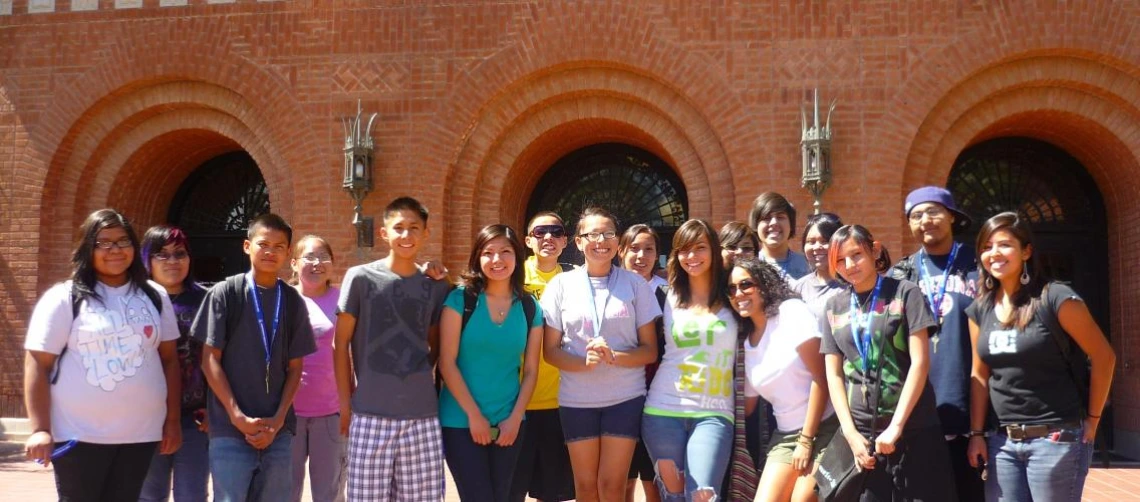Program Teaches High School Students Science, Engineering
Twenty-eight American Indian high school students have gained acceptance into a year-long program, benefiting those seeking degrees in the science, math, engineering and technology fields.

Twenty-eight students from throughout Arizona gathered in a room on the University of Arizona campus to build desktop computers from the ground up as part of the week-long Native American Science and Engineering Program.
The students arrived on Sunday and will leave campus on Saturday having gained insight on living in a dorm, UA admission requirements, financial aid and tutoring resources as well as insights into careers in the science, technology, engineering and mathematics fields.
The UA's Office of Early Academic Outreach coordinates the science and engineer summer workshop and subsequent year-long program created to provide Native American junior and senior high school students with the resources to enroll in a university and pursue a career in a science, technology, engineering or mathematics fields, known as STEM fields.
The program is known as NASEP and is a result of a partnership with the University of Alaska Anchorage and the National Science Foundation Partnership for Innovation Proposal titled Indigenous Alliance: Pre-College Component Expanding on Success.
For the last three years, the UA has joined nine other states in the Indigenous Alliance in attempting to effect a systematic change in the hiring patterns of Indigenous Americans in the STEM fields by increasing the number of students academically prepared to enter into those fields.
The UA NASEP program connects students with academic professionals and industry representatives from STEM fields and provides a year-long tutor to capitalize on the student's motivation to complete chemistry, physics and pre-calculus before graduating high school.
"These students represent the crème of the crop. They are students who have more than completed the requirements for admission into college by completing pre-calculus, chemistry and physics before completing high school," said Christine Nelson, a graduate assistant who helps coordinate the program.
While on campus, students will experience a combination of mentoring and experimental learning as exemplified by their first project. Students were assigned the construction of 28 desktop computers.
They were given computer components such as the mother board and software and were tasked to build a functional desktop computer. This year, the computer component parts were provided by the Student Affairs Systems Group who facillitated a four-hour instructional session on putting the computers together.
The computers will be distributed across campus and will be used by Student Affairs administrators.
Students will end the summer workshop with a new laptop computer, which they immediately will use to aid in their year-long participation in the program and in the college preparation.
The year-long components of the program include a weekly session with a UA tutor who will help the students succeed in their STEM-based high school courses.
That UA connection has proven to be a successful recruiting tool, with six of the 12 participants in last year's program committing to attend the UA.
Sixteen-year-old Shonto, Ariz. senior Seth Laughter has been accepted into the program two years in a row and takes the roll as a mentor seriously.
"I encourage other students and peers to take advanced courses and push themselves. I also help them with their classes. I enjoy taking challenging classes and want to be ready for college courses," Laughter said.
With the guidance of NASEP, and each student's dedication, participants have been accepted into schools such as the University of Washington, Columbia University, Arizona State University, Ft. Lewis College and Dartmouth. NASEP students have been awarded the Gates Millennium Scholarship and several university awarded scholarships.
The Office of Early Academic Outreach's College Knowledge for Counselors and othe programs has helped to get the word out about NASEP and other programs, said coordinator Amanda Cheromiah. She said the College Knowledge for Counselors program works with area high school and middle school counselors and parents to bridge the resource gap between college and high school. In January, the program held a workshop for 200 counselors representing schools statewide.
The NASEP program has grown. Cheromiah said the first year the program had 12 students, the second year the program grew to 16, and this year, 28 students represented the largest class with 40 student applicants vying for acceptance.
NASEP partners with various organizations to offer unique opportunities and mentorship for NASEP students including, but not limited to, the UA College of Optical Science, the National Optical Astronomy Observatory, Raytheon, Sandia National Laboratories, IBM, the UA Department of Mathematics, the UA College of Engineering and the UA President's Office.
Added Nelson: "The students leave here feeling empowered knowing that an investment has been made in their future and that they have been provided with the resources enabling them to succeed."
https://uanews.arizona.edu/story/program-teaches-high-school-students-science-engineering

